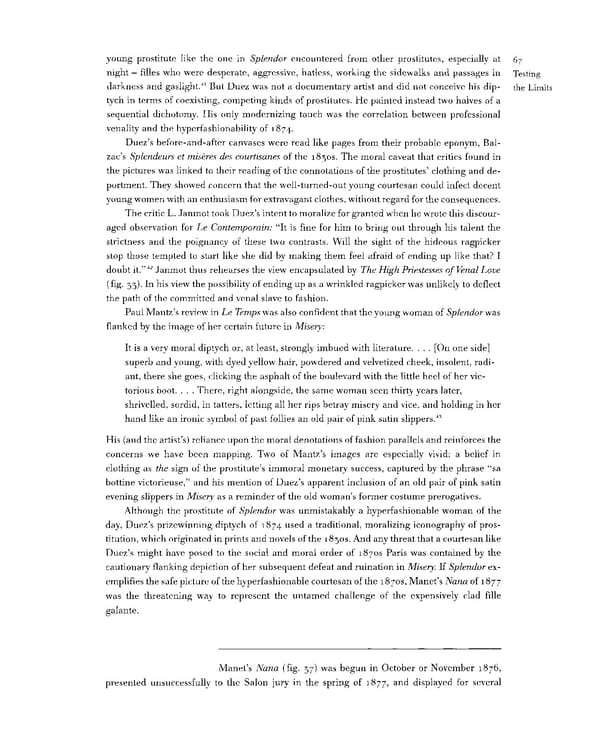young prostitute like the one in Splendor encountered from other prostitutes, especially at 67 night — filles who were desperate, aggressive, hatless, working the sidewalks and passages in Testing darkness and gaslight.41 But Duez was not a documentary artist and did not conceive his dip- the Limits tych in terms of coexisting, competing kinds of prostitutes. He painted instead two halves of a sequential dichotomy. His only modernizing touch was the correlation between professional venality and the hyperfashionability of 1874. Duez's before-and-after canvases were read like pages from their probable eponym, Bal- zac's Splendeurs et miseres des courtisanes of the 18305. The moral caveat that critics found in the pictures was linked to their reading of the connotations of the prostitutes' clothing and de- portment. They showed concern that the well-turned-out young courtesan could infect decent young women with an enthusiasm for extravagant clothes, without regard for the consequences. The critic L. Janmot took Duez's intent to moralize for granted when he wrote this discour- aged observation for Le Contemporain: "It is fine for him to bring out through his talent the strictness and the poignancy of these two contrasts. Will -the sight of the hideous ragpicker stop those tempted to start like she did by making them feel afraid of ending up like that? I 42 doubt it." Janmot thus rehearses the view encapsulated by The High Priestesses of Venal Love (fig. 33). In his view the possibility of ending up as a wrinkled ragpicker was unlikely to deflect the path of the committed and venal slave to fashion. Paul Mantz's review in Le Temps was also confident that the young woman of Splendor was flanked by the image of her certain future in Misery: It is a very moral diptych or, at least, strongly imbued with literature. . . . [On one side] superb and young, with dyed yellow hair, powdered and velvetized cheek, insolent, radi- ant, there she goes, clicking the asphalt of the boulevard with the little heel of her vic- torious boot. . . . There, right alongside, the same woman seen thirty years later, shrivelled, sordid, in tatters, letting all her rips betray misery and vice, and holding in her hand like an ironic symbol of past follies an old pair of pink satin slippers.45 His (and the artist's) reliance upon the moral denotations of fashion parallels and reinforces the concerns we have been mapping. Two of Mantz's images are especially vivid: a belief in clothing as the sign of the prostitute's immoral monetary success, captured by the phrase "sa bottine victorieuse," and his mention of Duez's apparent inclusion of an old pair of pink satin evening slippers in Misery as a reminder of the old woman's former costume prerogatives. Although the prostitute of Splendor was unmistakably a hyperfashionable woman of the day, Duez's prizewinning diptych of 1874 used a traditional, moralizing iconography of pros- titution, which originated in prints and novels of the 18308. And any threat that a courtesan like Duez's might have posed to the social and moral order of 18705 Paris was contained by the cautionary flanking depiction of her subsequent defeat and ruination in Misery. If Splendor ex- emplifies the safe picture of the hyperfashionable courtesan of the 18705, Manet's Nana of 1877 was the threatening way to represent the untamed challenge of the expensively clad fille gal ante. Manet's Nana (fig. 37) was begun in October or November 1876, presented unsuccessfully to the Salon jury in the spring of 1877, and displayed for several
 Prostitution & Impressionists Page 87 Page 89
Prostitution & Impressionists Page 87 Page 89